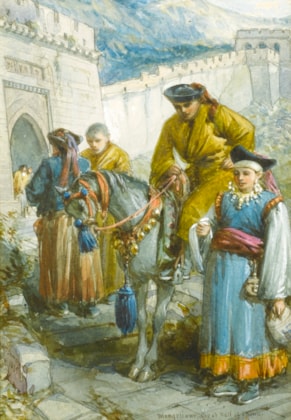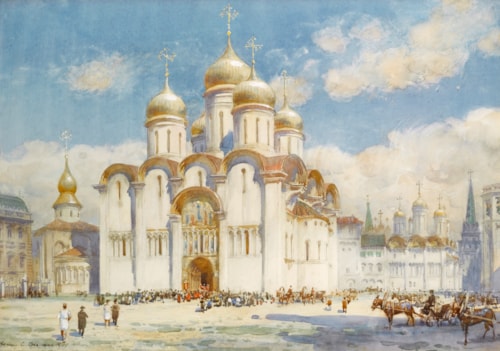ergey Osipovich Ovsyannikov
(Russian 1880 - 1937)
A House in North Africa
signed in Cyrillic (lower left)
watercolour on paper
21.5 x 27 cm (8½ x 10⅝ in)
The watercolour emerges from the buff paper, as though glimpsed through passing clouds. The opening reveals an exquisitely executed watercolour of considerable vibrancy. Vintage rose and mustard yellow coloured tiles line the side wall at the front of the house, which is perhaps situated in a North African city. Together with numerous other nineteenth-century Russian artists, Sergey Osipovich Ovsyannikov appears to have been attracted by the exotic architecture of North Africa, no doubt in his capacity as both an artist and an architect. A wave of terracotta tiles, like the closed mouth of a giant clam, ripples across the edge of the roof, which is supported by robust carved wooden beams. The iron grilles over each of the three windows are framed by a delicate frescoed lattice pattern, whilst the soft pink oleander flowers creep up over the perimeter wall, their vibrant colour standing out prominently against the azure-blue sky. The surrounding palms add to the exotic, enticing nature of the work.
Ovsyannikov demonstrates his great skill as a draughtsman through the layering of swathes of wash to create texture in the sky, and the fine use of the brush to create individual tufts of reeds growing in the dusky earth in the courtyard.
A Russian artist and architect, Ovsyannikov worked with the architect Leon Nikolaevich Benois (1856-1928), to build the exhibition wing of the Museum of Russian Art (1914-1919). In 1916, he designed a burial vault for officers fallen in World War I for the Transfiguration Cathedral in St. Petersburg, but the project was never realised. Other projects included a neo-Classical style building located on the right bank of the Kryukov canal in St. Petersburg, built in 1912-1914, and the Kuznechny Market (1925-1927) built in conjunction with A. S. Pronin. The Kuznechny Market was the first Soviet-built building for shopping, with statues of a worker and a peasant by the sculptor V. F. Razumovsky rising high above either side of the main entrance, echoing the Soviet ideal of the bond between the city and the country. Ovsyannikov also built the Krupskaya House of Culture, and at least one of the winter cottages in Olgino, fifteen kilometres northwest of St. Petersburg.
We are grateful to Vladimir Petrov for confirming the attribution of this work.
The watercolour emerges from the buff paper, as though glimpsed through passing clouds. The opening reveals an exquisitely executed watercolour of considerable vibrancy. Vintage rose and mustard yellow coloured tiles line the side wall at the front of the house, which is perhaps situated in a North African city. Together with numerous other nineteenth-century Russian artists, Sergey Osipovich Ovsyannikov appears to have been attracted by the exotic architecture of North Africa, no doubt in his capacity as both an artist and an architect. A wave of terracotta tiles, like the closed mouth of a giant clam, ripples across the edge of the roof, which is supported by robust carved wooden beams. The iron grilles over each of the three windows are framed by a delicate frescoed lattice pattern, whilst the soft pink oleander flowers creep up over the perimeter wall, their vibrant colour standing out prominently against the azure-blue sky. The surrounding palms add to the exotic, enticing nature of the work.
Ovsyannikov demonstrates his great skill as a draughtsman through the layering of swathes of wash to create texture in the sky, and the fine use of the brush to create individual tufts of reeds growing in the dusky earth in the courtyard.
A Russian artist and architect, Ovsyannikov worked with the architect Leon Nikolaevich Benois (1856-1928), to build the exhibition wing of the Museum of Russian Art (1914-1919). In 1916, he designed a burial vault for officers fallen in World War I for the Transfiguration Cathedral in St. Petersburg, but the project was never realised. Other projects included a neo-Classical style building located on the right bank of the Kryukov canal in St. Petersburg, built in 1912-1914, and the Kuznechny Market (1925-1927) built in conjunction with A. S. Pronin. The Kuznechny Market was the first Soviet-built building for shopping, with statues of a worker and a peasant by the sculptor V. F. Razumovsky rising high above either side of the main entrance, echoing the Soviet ideal of the bond between the city and the country. Ovsyannikov also built the Krupskaya House of Culture, and at least one of the winter cottages in Olgino, fifteen kilometres northwest of St. Petersburg.
We are grateful to Vladimir Petrov for confirming the attribution of this work.





 contact
contact contact
contact +44 20 7313 8040
+44 20 7313 8040









